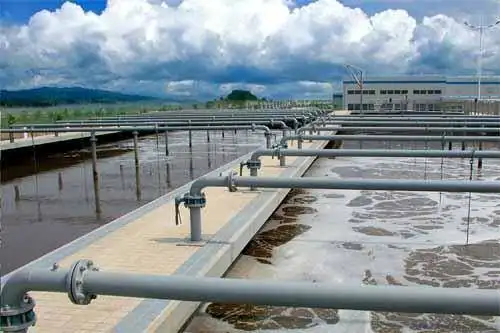News
Wastewater treatment

Physical treatment of wastewater
Wastewater physical treatment is a method to separate and remove insoluble suspended pollutants (including oil film and oil droplet) in wastewater through physical action. The chemical properties of pollutants do not change during treatment. The methods are as follows: ① Gravity separation method. Its treatment units include sedimentation, flotation (air flotation), etc. The treatment equipment used is sedimentation tank, grit chamber, oil separator, air flotation tank and its accessories. ② The centrifugal separation method itself is a treatment unit, and the equipment used includes centrifugal separator, water cyclone separator, etc. ③ The screen filtration interception method has two treatment units: screen filtration and filtration. The former uses grid and screen mesh, and the latter uses sand filter tank, microporous filter, etc. In addition, there are wastewater evaporation treatment, wastewater gas-liquid exchange treatment, wastewater high gradient magnetic separation treatment, wastewater adsorption treatment, etc. Advantages of physical treatment method: most of the equipment is simple, easy to operate, and the separation effect is good, so it is widely used.
Chemical treatment of wastewater
Wastewater chemical treatment is a wastewater treatment method that uses chemical reaction and mass transfer to separate and remove dissolved and colloidal pollutants in wastewater or convert them into harmless substances. Treatment units based on chemical reaction generated by adding chemicals include coagulation, neutralization, oxidation and reduction, etc; Treatment units based on mass transfer include extraction, stripping, stripping, adsorption, ion exchange, electroosmosis and reverse osmosis. There are wastewater neutralization treatment, wastewater coagulation treatment, wastewater chemical precipitation treatment, wastewater oxidation treatment, wastewater extraction treatment, etc. Compared with biological treatment, it can remove more pollutants quickly and effectively, and can be used as a tertiary treatment measure after biological treatment. This method also has the advantages of easy operation, automatic detection and control, and recycling. Chemical treatment can effectively remove many kinds of highly toxic and highly toxic pollutants from wastewater.
Physical and chemical treatment of wastewater
The method of wastewater physical-chemical treatment uses the combined action of physics and chemistry to purify wastewater. It is a wastewater treatment system consisting of physical and chemical methods, or a single treatment method including physical and chemical processes, such as flotation, blowing off, crystallization, adsorption, extraction, electrolysis, electrodialysis, ion exchange, reverse osmosis, etc. For example, the two-stage treatment of chemical coagulation precipitation and activated carbon adsorption used to remove suspended and dissolved pollutants is a typical physical and chemical treatment system. Compared with biological treatment, this method has the following advantages: less land occupation; The effluent quality is good and stable; It has strong adaptability to changes in wastewater volume, temperature and concentration; It can remove harmful heavy metal ions; The effect of phosphorus, nitrogen and color removal is good; The management operation is easy for automatic detection and automatic control. However, the equipment cost and daily operation cost of the processing system are high.
Biological treatment of wastewater
Wastewater biological treatment method, also known as "wastewater biochemical treatment method" or "wastewater biochemical treatment method" for short, is a method that uses the metabolism of microorganisms to convert dissolved and colloidal organic pollutants in wastewater into harmless substances to achieve purification. It can be divided into wastewater aerobic biological treatment method and wastewater anaerobic biological treatment method. The former mainly includes activated sludge method, biofilm method, oxidation pond method, sewage irrigation, etc. It is a wastewater treatment method to transform the organic pollutants in solution, colloid and micro suspension into stable and harmless substances through the metabolism of microorganisms. According to different microorganisms, biological treatment methods can be divided into aerobic biological treatment and anaerobic biological treatment. The aerobic biological treatment method is widely used for wastewater biological treatment. According to tradition, the aerobic biological treatment method can be divided into activated sludge method and biofilm method. The activated sludge process itself is a kind of treatment unit, which has multiple operation modes. The treatment equipment of biofilm process includes biological filter, biological rotary table, biological contact oxidation, biological fluidized bed, etc. Biological oxidation pond method is also called natural biological treatment method. Anaerobic biological treatment, also known as biological reduction treatment, is mainly used to treat high concentration organic wastewater and sludge. The treatment equipment used is mainly digestion tank. The biological contact oxidation process is used to treat wastewater, that is, the biological contact oxidation process is used to fill the biological reaction tank with fillers. The oxygenated sewage submerges all the fillers and flows through the fillers at a certain flow rate. The filler is covered with biofilm, and the sewage is widely contacted with the biofilm. With the metabolism of microorganisms on the biofilm, the organic pollutants in the sewage are removed and the sewage is purified. Finally, the treated wastewater will be discharged into the biological contact oxidation treatment system and mixed with domestic sewage for treatment, and will be discharged after chlorine disinfection. The biological contact oxidation process is a biofilm process between the activated sludge process and the biofilter process. It is characterized by the arrangement of fillers in the tank, aeration at the bottom of the tank to oxygenate the sewage (generally, aeration by Roots blower and mechanical aeration), and the flow of sewage in the tank to ensure that the sewage is fully contacted with the fillers immersed in the sewage, Avoid the defect of uneven contact between sewage and filler in biological contact oxidation tank.
Biochemical treatment
Ion exchange method is a wastewater treatment method that converts organic pollutants in solution, colloid and micro suspension into stable and harmless substances through the metabolism of microorganisms. Biological treatment methods can be divided into aerobic biological treatment method and anaerobic biological treatment method according to the microorganisms that work.
Welcome to contact:+8618013418091(Whatsapp/Wechat)
+8618013418097(Whatsapp/Wechat)
 Alvin
Alvin hugh778
hugh778